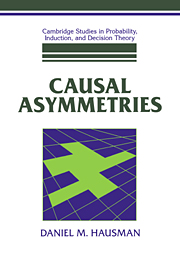Book contents
- Frontmatter
- Contents
- List of Figures
- Acknowledgments
- Introduction: Causation and its Asymmetries
- 1 Metaphysical Pictures and Wishes
- 1* Transfer Theories
- 2 Is Causation a Relation Among Events?
- 3 Causation, Regularities, and Time: Hume's Theory
- 4 Causation and Independence
- 4* Causation, Independence, and Causal Connection
- 5 Agency Theory
- 5* Causal Generalizations and Agency
- 6 The Counterfactual Theory
- 6* Independence and Counterfactual Dependence
- 7 Counterfactuals, Agency, and Independence
- 7* Agency, Counterfactuals, and Independence
- 8 Causation, Explanation, and Laws
- 8* Causation, Explanation, and Independent Alterability
- 9 Probabilistic Causation
- 10 Causation and Conditional Probabilities
- 10* Causal Graphs and Conditional Probabilistic Dependencies
- 11 Intervention, Robustness, and Probabilistic Dependence
- 11* Interventions and Conditional Probabilities
- 12 Operationalizing and Revising the Independence Theory
- 12* Probability Distributions and Causation
- 13 Complications and Conclusions
- Appendix A Alphabetical List of Propositions
- Appendix B List of Theorems
- References
- Index
4 - Causation and Independence
Published online by Cambridge University Press: 20 April 2010
- Frontmatter
- Contents
- List of Figures
- Acknowledgments
- Introduction: Causation and its Asymmetries
- 1 Metaphysical Pictures and Wishes
- 1* Transfer Theories
- 2 Is Causation a Relation Among Events?
- 3 Causation, Regularities, and Time: Hume's Theory
- 4 Causation and Independence
- 4* Causation, Independence, and Causal Connection
- 5 Agency Theory
- 5* Causal Generalizations and Agency
- 6 The Counterfactual Theory
- 6* Independence and Counterfactual Dependence
- 7 Counterfactuals, Agency, and Independence
- 7* Agency, Counterfactuals, and Independence
- 8 Causation, Explanation, and Laws
- 8* Causation, Explanation, and Independent Alterability
- 9 Probabilistic Causation
- 10 Causation and Conditional Probabilities
- 10* Causal Graphs and Conditional Probabilistic Dependencies
- 11 Intervention, Robustness, and Probabilistic Dependence
- 11* Interventions and Conditional Probabilities
- 12 Operationalizing and Revising the Independence Theory
- 12* Probability Distributions and Causation
- 13 Complications and Conclusions
- Appendix A Alphabetical List of Propositions
- Appendix B List of Theorems
- References
- Index
Summary
This chapter presents what I believe to be the central asymmetry of causation. The ideas first occurred to me early in 1981 and derive from work by Herbert Simon (1953) and Douglas Ehring (1982). The central intuition is that causal priority consists in the causal connection among effects of a common cause and the causal independence among the causes of a given effect. For this reason I call this view the independence theory of causal priority.
Causal Connection and Probabilistic Dependency
J. L. Mackie suggests that one can factor the causal relation into a symmetrical relation of “causal connection” and an asymmetrical relation of “causal priority”: For all events a and b, a causes b iff a is causally connected to b and a is causally prior to b. In Mackie's view, to say that a and b are causally connected is to say “a and b are connected by some fact of causation” (Mackie 1980, p. 85). Causal connection is the topic of this section and of chapter 12, while causal priority is the topic of the whole book. Humeans, for example, take a to be causally prior to b if a precedes b, and they take a to be directly causally connected to b iff a and b are distinct and contiguous and one is necessary and sufficient in the circumstances for the other.
I share Mackie's intuition that causation has both a symmetrical and an asymmetrical aspect. The symmetrical part is akin to Hume's notion of a necessary connection.
- Type
- Chapter
- Information
- Causal Asymmetries , pp. 55 - 74Publisher: Cambridge University PressPrint publication year: 1998



